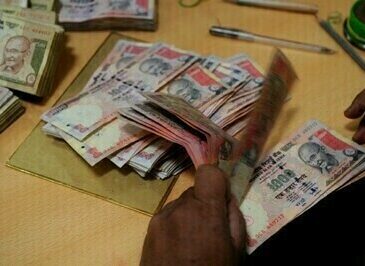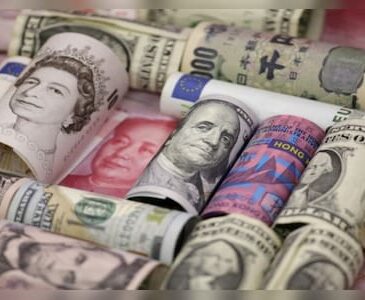

baona / iStock.com
Commitment to Our Readers
GOBankingRates’ editorial team is committed to bringing you unbiased reviews and information. We use data-driven methodologies to evaluate financial products and services – our reviews and ratings are not influenced by advertisers. You can read more about our editorial guidelines and our products and services review methodology.

20 Years
Helping You Live Richer


Trusted by
Millions of Readers
Money transformed the entire idea of the barter system. A medium of exchange for goods and services for centuries, money keeps matters of the world in a flow, helps countries exchange goods and services, store wealth and develop friendly relationships.
Typically, every country has a central bank that regulates and publishes the money supply data in coordination with the government.
Money is present in various forms: physical — coins, notes — and virtual — electronic bank accounts, cryptocurrencies. This makes it hard to determine how much money exists in the world right now.
What Are Different Types of Money?
Economists divide money into categories based primarily on how liquid it is, according to the Federal Reserve Bank of Richmond. The range starts at the narrowest and most liquid with M0 and, in the U.S., goes up to the broadest and least liquid, M3. Each M level includes the levels that precede it, so M3 includes M0, M1 and M2.
The central bank in the U.S. is the Federal Reserve System, which publishes U.S. currency data based on three of the four Ms:
How Money Supply Is Measured
- M0: Referred to as the monetary base, M0 includes all the money in circulation, including money banks hold in reserve. According to the Federal Reserve, there was about $2.3 trillion in circulation as of February 2024.
- M1: It includes all the M0 money supply, adding the money held in travelers’ checks, demand deposits, other types of checkable deposits and negotiable orders of withdrawal. As of February 2024, the seasonally adjusted stock of M1 totaled $17.99 trillion.
- M2: It includes all of the currency from the M1 money supply, and expands to include mutual funds, smaller time deposits, money market securities and other types of time deposits. M2 currencies are usually less liquid than M1, meaning you can’t convert M2 money into cash as easily. The total stock of M2 was $20.78 trillion in January.
- M3: It includes all the elements of M2, plus institutional money market funds and large time deposits. As compared to M1 and M2, M3 assets have the lowest liquidity. The Fed no longer calculates M3.
After covering different types of money and how much is circulating and held in the U.S., here’s a look at the important question: “How much money is there in the world?”
How Much Money Is in the World?
The total amount of money in the world can be measured and expressed in many different ways, so it’s difficult to give a specific answer.
If you’re curious about the total value of notes and coins in circulation, the Bank for International Settlements estimated it to be $8,275,000,000,000, or $8.28 trillion U.S. dollars, across 20 major countries plus the euro area in 2021, its most recent estimate. Of course, there are nearly 200 countries in the world, so this is just a rough estimate of the most narrowly defined — and perhaps easiest to quantify — category of money.
The global M1 supply, which includes all the money in circulation plus travelers checks and demand deposits like checking and savings accounts, was $48.9 trillion as of Nov. 28, 2022, according to Visual Capitalist. That publication estimated the total value of the M2 supply to be $82.6 trillion.
Money is also present in the form of investments and derivatives. The total market capitalization of just the New York Stock Exchange and Nasdaq was $48.97 trillion as of December 2023, according to Statista. The total market cap of cryptocurrency, as reported by CoinMarketCap, adds another $2.43 trillion to that figure.
Good To Know
The world’s top 10 billionaires from the Forbes Real-Time Billionaires List have a total net wealth of $1.59 trillion as of March 22.
Future of Money: Is Cash Going to Be Replaced?
With countries striving hard to stabilize their economies, the total amount of money in circulation is expected to increase continuously.
Currently, more people are being drawn towards using virtual or digital currencies. This is why the use of physical money is gradually decreasing with the increased popularity of digital transactions.
China, Japan and Sweden are in various stages of developing central bank digital currency, according to The New York Times. The Bank of England and the European Central Bank are also exploring CBDCs. The Bahamas has already launched the world’s first official digital currency.
Final Take
There is nearly $83 trillion in the total global money supply, $48.9 trillion of which is M1. Even if digital currencies render physical money obsolete, the kinds of currencies central banks are considering would still be quantifiable — just as you can quantify your bank balance or the value of your investment portfolio despite the absence of physical money in those accounts.
FAQ
Here are more answers to questions about money and currency in the world today.- Which currency is the most valuable in the world?
- The most valuable currency in the world is the Kuwaiti Dinar (KWD). One U.S. dollar equals 0.31 KWD.
- What’s the total value of cryptocurrencies?
- The current market capitalization of cryptocurrency is $2.43 trillion, as of March 22, 2024.
- What is the world’s total wealth?
Amber Barkley and Daria Uhlig contributed to the reporting for this article.
Information is accurate as of March 22, 2024, and is subject to change.
Our in-house research team and on-site financial experts work together to create content that’s accurate, impartial, and up to date. We fact-check every single statistic, quote and fact using trusted primary resources to make sure the information we provide is correct. You can learn more about GOBankingRates’ processes and standards in our editorial policy.
Source link




